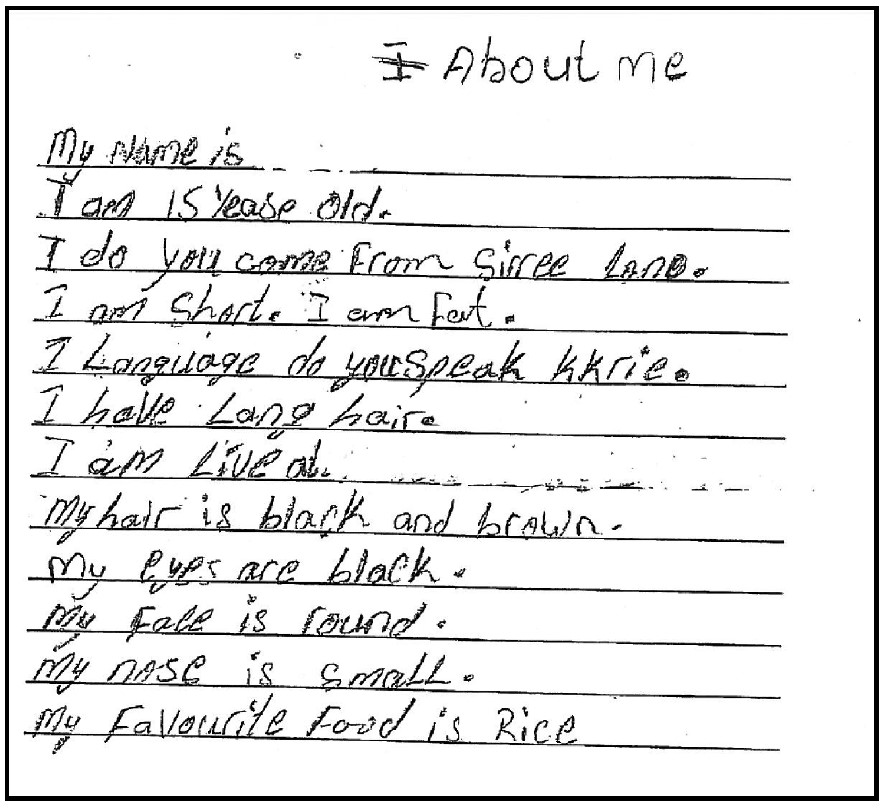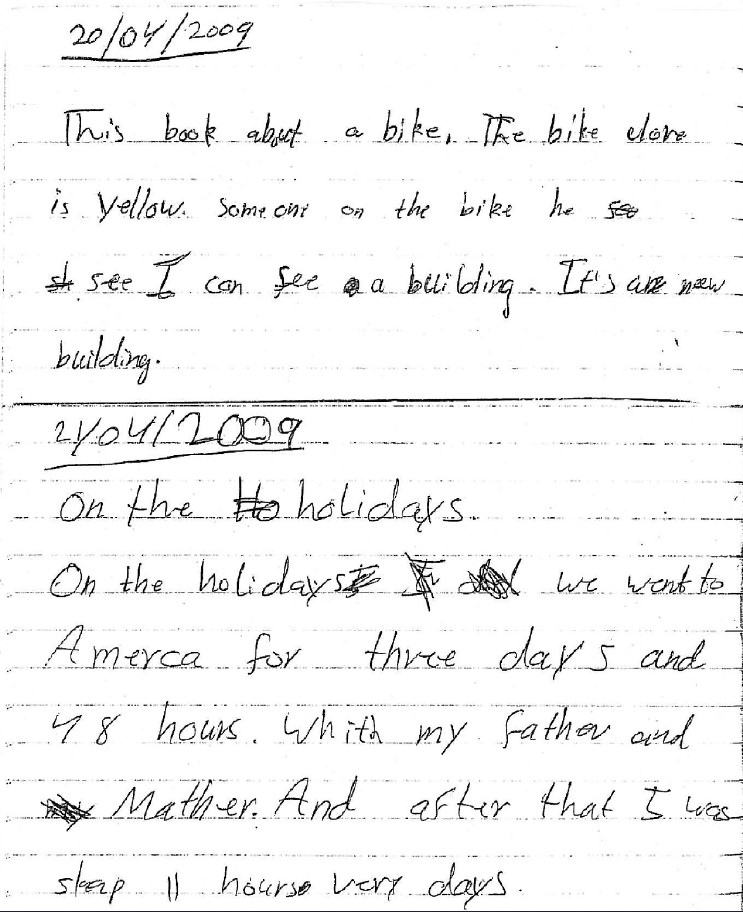The student work samples on this page are also available to download:
CL Writing proficiency levels and Achievement Standard
The students' performance in these tasks suggest that they are working within the range of Level CL in Writing. The assessing teacher will need to consider a range of student samples in order to determine whether each student is at the beginning of CL, consolidating CL or at the CL standard in Writing.
At beginning Level CL students:
- experiment with a range of drawing and writing implements, such as pens, pencils, crayons, and rulers, but not for communicative purposes
or
- use drawings in an attempt to convey meaning or a story
and/or
- can copy and trace letters and numbers, demonstrate an awareness of writing and layout conventions of text, for example, left to right, spaces between words, and the position of a heading or title, and form and place letters on the line, with assistance
and/or
- have begun to experiment with the computer as a writing tool, such as recognising letters on the keyboard.
At consolidating Level CL students:
- have begun to expect that writing is part of school learning
- have begun to write letters and numbers independently, and have begun to experiment with punctuation, including upper- and lower-case letters
- can check the accuracy of their own writing against the original, with prompting
- have begun to use very basic strategies to support their own writing, such as sounding out words phonetically, using a simple dictionary or word list, or using 'look, say, cover, write, check' to learn new words, with assistance.
At
Level CL Achievement Standard students:
- write short, grammatically simple texts based on well-rehearsed spoken and well-practised written English in familiar contexts
- write for a range of basic classroom and personal purposes, such as making lists and writing simple journal entries and notes, and they complete activities following models
- demonstrate an early awareness that print texts in English are presented according to certain conventions, which change according to context and purpose
- produce texts that use familiar sentence patterns from well-known texts or classroom models
- begin to use conventional letter formations when writing or copying, attending to the relative sizes and shapes of letters, their position on the line and basic punctuation
- leave appropriate spaces between words
- attempt to write some new words using their developing knowledge of the sound–symbol system in English, personal dictionaries and glossaries, and resources in the classroom, and by asking for assistance
- copy texts using basic features in software applications.
Informative text - About Me
Student information
The student is 15 years old and speaks Kerio. The student was born in Sierra Leone and had recently arrived in Australia. They have had interrupted schooling and spent three months in an English language school in Victoria.
Task
The class was asked to write a text about themselves. Students learned the language and sentence structures required to provide personal information and describe their physical features. This task was set as an extension activity for students who had completed their persona profile booklet. The text became a preparation for the students' oral presentations about themselves.

Text
About Me
My name is [redacted]
I am 15 Yease old.
I do you come From Sirree Lono.
I am short. I am Fat.
I Langauge do you speak kkrie.
I have Long hair.
I am live at [redacted]
My hair is black and brown.
My eyes are black.
My Face is round.
My nose is smaLL.
My Favourite Food is Rice
This sample of student work demonstrates that the student can:
- Write short, simple texts for specific purposes related to personal experience
(VCEALC525)
- Show an awareness of purpose and audience when presenting work
(VCEALA528)
- Spell familiar, simple words correctly, using knowledge of letter–sound relationships
(VCEALL541)
- Use basic punctuation
(VCEALL542)
Possible next steps for this student's learning
- Writing using sentence starters, for example,
I come from… (VCEALL534)
- Reading aloud their own writing and identifying errors in their sentences, with teacher support
(VCEALA530)
- Creating a profile for a friend and writing sentences to describe their friend using the appropriate pronouns
(VCEALC525)
Pathways and transitions considerations
A Year 9 student who is working within the range of Level CL in any one language mode is not ready to transition to the English curriculum regardless of their proficiency in the other two language modes. This student will continue on Pathway C of the EAL curriculum.
Informative text - Text response about a bike and recount about holiday
Student information
This student is 17 years old and in Year 9. He is of Afghani background and has been in Australia for about a year. He speaks Pashtu. He does not have any prior schooling and attended an English language school before starting in a secondary school in Victoria.
Task
This is a journal writing task set within an intensive English class. It is a task familiar to the student. The first sample is a response to a text about a bike, while the second writing is on the student's own choice of topic. No scaffolding was provided.

Text
20/04/2009
This book about a bike. The bike clore is yellow. Someone on the bike he see I can see a building. It’s an neew building.
21/04/2009
On the holidays
On the holidays we went to Amerca for three days and 48 hours. Whith my father and Mather. And after that I was sleap 11 hours very days.
This sample of student work demonstrates that the student can:
- Write short, simple texts for specific purposes related to personal experience
(VCEALC525)
- Write familiar words and simple sentences independently, with enough accuracy to convey meaning
(VCEALC526)
- Write sentences that reflect oral language with some examples of correct word order
(VCEALL536)
- Use basic conjunctions to connect ideas
(VCEALL537)
- Use simple verbs
(VCEALL538)
- Spell familiar, simple words correctly, using knowledge of letter–sound relationships
(VCEALL541)
- Use basic punctuation
(VCEALL542)
Overall, this student can also:
Possible next steps for this student's learning
- Using visuals or key vocabulary on flash cards to plan, organise and sequence ideas for writing
(VCEALL540)
- Understanding and using a basic structure for a text response
(VCEALC525)
- Using a basic structure and guiding questions to write a personal recount
(VCEALC527)
- Learning and practising sentences with different grammatical structures, for example, simple compound sentences
(VCEALL535)